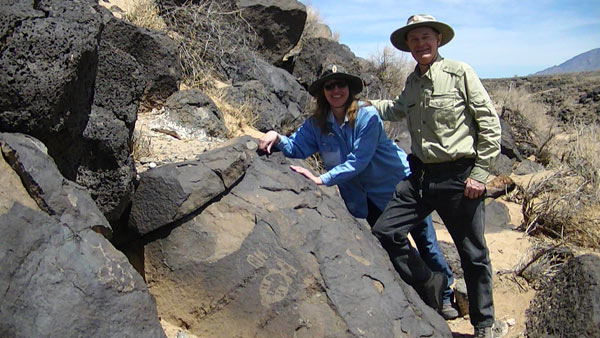History etched in stone
Updated: 2014-01-11 23:55
By Mike Peters (China Daily)
|
||||||||
 |
| Ruskamp and his wife Linda climb in New Mexico. Photo provided to China Daily |
"The challenge was: Could I find more?" Ruskamp says. "I did — distinctive images of fruit trees and animals, for example — hundreds of them." Such Bronze-era Chinese script definitely dates between 1200 and 200 BC, and "between 900 to 500 BC is the best guess", he says.
While many academic experts have been skeptical, one of the leading Western experts in Chinese script has supported Ruskamp's work.
"You have a Shang ancestor up there, the third Shang king," Ruskamp recalls being told by David N. Keightley, professor emeritus at the University of California at Berkeley and well-known scholar of ancient Chinese script.
"So this is no longer a chance doodle by somebody walking through," Ruskamp recently told experts at Paths Across the Pacific VIII, a conference on cross-continented migration held in Sitka, Alaska. Ruskamp used the event to roll-out the research findings in his just-published second edition of Asiatic Echoes: The Identification of Ancient Chinese Pictograms in Pre-Columbian North American Rock Writing.
"The mostly PhD-level scientific audience overwhelmingly embraced my presentation as conclusive proof for the presence of pre-Columbian Asiatic entry into the Americas, likely around 900-500 BC," he says.
But while Keightley reviewed Ruskamp's book positively and made supportive annotations on the photos, other experts in both the West and China find the dates involved hard to accept.
Ruskamp understands.
"This has not been an easy study to carry out," he says. "Knowledge of both the form of ancient Chinese scripts, Native American folklore and the styles of native rock art are required."
Ruskamp says that if skeptics doubt that Chinese brought their culture to the Americas at least five centuries before Christ, they must believe that the same written language evolved independently, just by chance. The oracle-bone script, carved on turtle shells by the scribes of the Zhou Dynasty (c.11th century-256 BC) was extinct for hundreds of years — only rediscovered in 1899.
"For these things to be phony, they would have to have been created in the past 120 years," he says. His book describes how independent testing of the rock art and its weathering have proved that the carved images are much older.
The narrow historical period of that long-dead writing allows modern scientists to "nail down the date — something that normally in rock art we can't do", he says. "Many examples seem to be classic oracle-bone divination.
"I've published 53 different examples, from the US Southwest to Canada. It's an open script — people across the continent knew what it meant."
But such research, he notes, is a highly speculative endeavor with admittedly a very low probability of success.
"I wouldn't be doing it unless it was enjoyable in its own right," he says with a laugh.
Contact the writer at michaelpeters@chinadaily.com.cn.

 Gorgeous Liu Tao poses for COSMO magazine
Gorgeous Liu Tao poses for COSMO magazine
 Post-baby Duchess
Post-baby Duchess
 Victoria Beckham S/S 2014 presented during NYFW
Victoria Beckham S/S 2014 presented during NYFW
 'Despicable' minions upset Depp's 'Lone Ranger' at box office
'Despicable' minions upset Depp's 'Lone Ranger' at box office
 'Taken 2' grabs movie box office crown
'Taken 2' grabs movie box office crown
 Rihanna's 'Diamonds' tops UK pop chart
Rihanna's 'Diamonds' tops UK pop chart
 Fans get look at vintage Rolling Stones
Fans get look at vintage Rolling Stones
 Celebrities attend Power of Women event
Celebrities attend Power of Women event
Most Viewed
Editor's Picks

|

|

|

|

|

|
Today's Top News
Former Israeli PM Ariel Sharon dead at 85
Overseas investment leads growth
Fire in China's Shangri-la put out
US to withdraw diplomat at India's request
Top scientists awarded $826,000
Eight foreign scientists win Chinese sci-tech awards
New documents released in NJ bridge scandal
Nation 'has landed trading crown'
US Weekly

|

|







